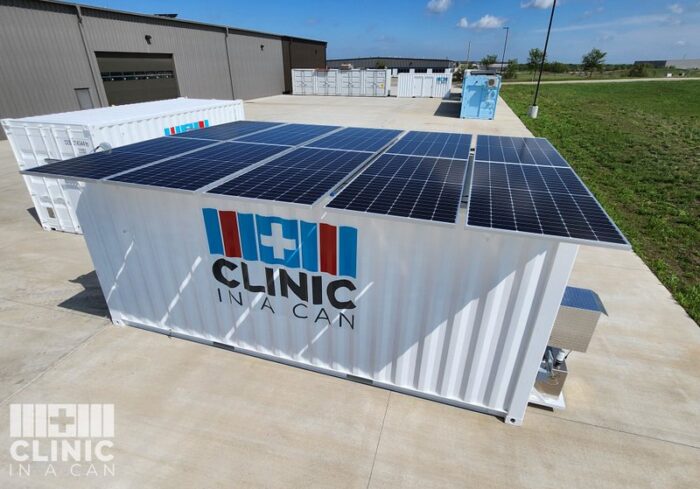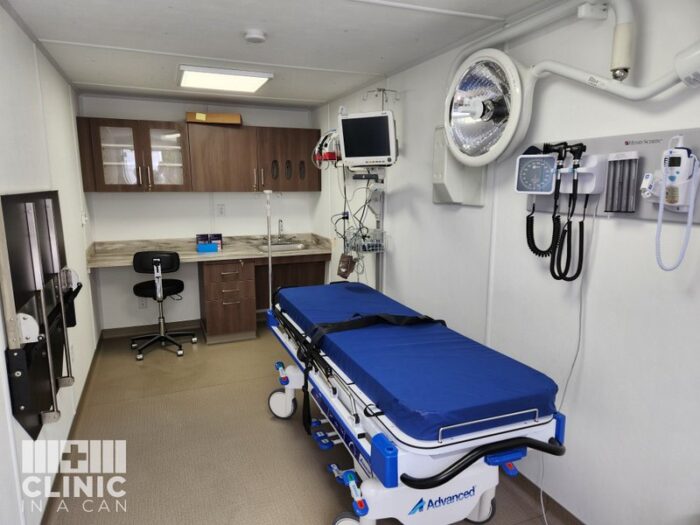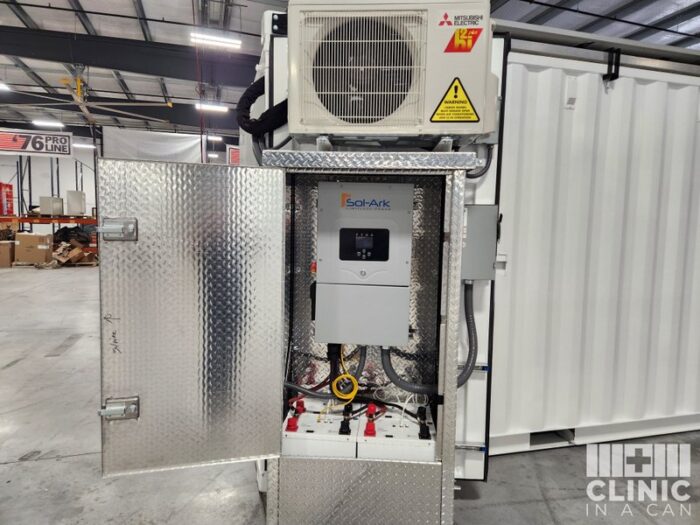Clinic in a Can is just that, powered by solar + battery storage

From the United States to Ukraine, Honduras and South Africa, for the past two decades, Clinic In A Can has created and deployed nearly 170 ready-to-use medical facilities. The clinics are constructed from recycled steel shipping containers and delivered throughout the world to villages, towns, war zones, jungles, deserts and just about any location that lacks access to medical care or has been hit by a natural disaster.
The self-sufficient, free-standing 20-foot clinics are outfitted with the necessary equipment and, once delivered, can be up and running within a few hours. The clinics don’t rely on external power since most are equipped with six to 10 solar panels that provide up to 4400 watts.
To avoid power disruptions, the solar system is backed up by four compact AmpliPHI 3.8 batteries from Briggs & Stratton Energy Solutions that provide 15.2 kWh and a 15K inverter from Sol-Ark. The batteries store extra solar energy and provide power when the solar panels aren’t sufficiently available.
“We’ve learned over the years that solar with batteries is one of the best solutions for turnkey power and system redundancy,” says Michael Wawrzewski III, founder and CEO of Clinic In A Can. “We’re focused on providing medical care, no matter what the surrounding circumstances are, so building power into our clinics is one of the essential components that’s required to keep a clinic up and running.”
Inside Clinic in a Can

Many of the clinics are custom-built for the need at hand and provide secure, climate-controlled environments for medical practitioners and patients. In addition to the 20-foot model, 40-foot or 53-foot clinics that include a bathroom and waiting room with a check-in kiosk are also available. The units can be configured for primary care purposes with basic equipment like an exam table and procedure lights to a more advanced emergency/trauma unit with digital compact X-ray units, GE Venue ultrasound and Abbott I-stat Point of Care portable blood analysis system.
A standard primary care clinic comes with: an air conditioning unit with an integrated heat pump; LED lighting; six universal duplex electrical outlets; standard telephone with exterior communication port access panel; an external water supply connection and external grey water waste connection; certified safety container (CSC); medical cabinetry; and a stainless steel sink with goose neck faucet.
“Our clinics contain a significant amount of equipment but we’ve engineered them to be very energy efficient and have selected products that meet our power needs,” says Wawrzewski. “Even with air conditioning, they normally draw 250 watts a day. We may peak at 1200 watts but that’s not a problem.”

For facilities like 20-foot dental clinics that are “power hogs” due to the dental compressor and suction equipment, four AmpliPHI batteries delivering 15.2 kWh are specified to ensure continual power. In addition, any projects that Clinic In A Can does for the U.S. government or military also include four batteries to ensure the clinic has 48 hours of backup power.
“The AmpliPHI batteries have a number of advantages,” says Wawrzewski. “People recognize the Briggs & Stratton name so that makes them feel comfortable. We like the powder coated housing and paint finish because it’s durable and stands up to any climate. Plus, there’s a breaker switch on the top that allows individual batteries to be turned on and off and the batteries are small and easy to lift into place.”
To respond quickly to disaster situations, Clinic In A Can has pre-built units that can go out the door in an hour. Pre-built solar-powered models with batteries can be turned around in 72 hours. Depending on the situation, the clinics are transported by cargo ship or flown in the belly of a transport plane.
“Too often, people suffer and die needlessly because they don’t have access to simple medical treatment,” says Wawrzewski. “Originally, I founded the non-profit Hospitals of Hope to meet that need by building a brick-and-mortar Level II hospital in Vinto, Bolivia in 1998. The experience taught me valuable lessons that led to establishing Clinic In A Can in 2004. Our first clinic was made from a semi-trailer and that was used to deliver aid to victims of Hurricane Katrina in 2005 and later it was sent to Haiti. Since then, we’ve perfected our engineering and manufacturing process resulting in a durable, energy efficient, containerized medical solution which has helped increase healthcare access in 26 countries. We believe geography shouldn’t be the deciding factor if someone lives or dies.”




Comments are closed here.